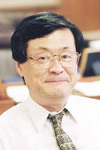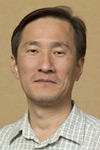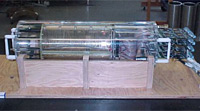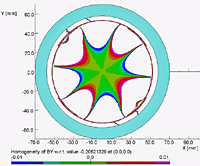 |
|
|
 |
Japanese Diet Members to Promote the ILC

Hirotaka Sugawara |
The first general meeting of the "Federation of Diet members to promote the realisation of ILC" was held in Tokyo, Japan on 15 June. The role of this group of 'Diet members', which are equivalent to members of congress, is to promote the ILC in Japan. As an important international project in the fundamental sciences, the Federation decided to give strong support toward the realisation of the ILC.
Fifty-five Diet members from the Liberal Democratic Party, the majority party in Japan, established the Federation. Twenty-seven of the members are listed as founders.
Kaoru Yosano, the Minister in charge of economic and fiscal policy, and financial affairs, is the Chair of the Federation. Takeo Kawamura, former minister of the ministry of education, culture, sports and science, will be the General Secretary and Eisuke Mori, former vice-ministry of health, labour and welfare will be the Bureau Chief. An industry leader Etsuhiko Shouyama, a member of the Counsil for Science and Technology Policy and a vice president of Japan Federation of Economic Organization, also CEO of Hitachi, Ltd., a Nobel Prize winner Masatoshi Koshiba, Professors Kazuhiko Nishijima and Jun-ichi Nishizawa also attended the meeting. "It is a very important step towards the realisation of the ILC," said Hirotaka Sugawara, Chair of the advisory committee to KEK-DG concerning the ILC project and former director general of KEK, who was also invited to the meeting. "It is, therefore, a very delightful event for the world community of high energy physics."
-- Nobuko Kobayashi, KEK |
 |
|
|
 |
Korean GDE member Kim moves to Kyungpook National University

Eun-San Kim |
Eun-San Kim, a member of Global Design Effort, recently moved from Korea's Pohang Accelerator Laboratory (PAL) to become a professor at the department of Physics in Kyungpook National University in Korea. Ever since he started, he has performed a leading role in R&D for the ILC in universities and institutes of Korea. He organises and leads groups for R&D topics on damping rings, ring-to-main-linac (RTML), beam diagnostics and superconducting RF cavities in Korea for the ILC. He is also a co-leader of the Area System Group for RTML and has worked on damping ring designs and short bunch compressors for the BCD and RDR.
During his time at PAL, he mainly worked on accelerator physics, contributed to raising performances of the Pohang Light Source storage ring, and performed R&D on designs of 4th generation light sources, such as Free Electron Lasers and Energy Recovery Linacs. In addition to this, he participated in the ILC project and joined the R&D groups for the ILC at KEK in 2005 and 2006.
Read more...
-- Youhei Morita |
 |
|
|
 |
|
 |
 |
|
|
 |
The Canadian ILC Group and the Time Projection Chamber

A 30 cm TPC prototype that the ILC Canada group built and used in magnetic field tests at TRIUMF and DESY. |
Although it sounds like a device used on Star Trek, a Time Projection Chamber (TPC) is a gas-filled cylindrical chamber that acts like a three-dimensional electronic camera, making a photo-copy of a particle track as it flies through the detector. For about a decade now, a group of scientists in Canada has been developing and testing Micro-Pattern Gas Detectors (MPGD), contributing to the worldwide R&D for a high resolution TPC tracker for the future International Linear Collider.
Similar to a bubble chamber but with electronic readouts at either end, the TPC was invented by Dave Nygren of Lawrence Berkeley Laboratory in the 1970s. The TPC is a mostly empty, gas-filled cylinder with proportional wire readouts at each end.
Any charged particle passing through the cylinder liberates electrons from
the gas molecules along its path, and due to the presence of a strong
electric field, the trail of electrons drift to the wires at each end.
By measuring the position of these electrons on the endplate and the time they take to arrive, physicists can determine the momentum of the charged particle and reconstruct the particle trajectory in three dimensions. "The TPCs could make measurements quite well in those early days, but they never did make measurements as well as they could in principle," said Carleton University's Madhu Dixit.
Dixit has spent the past 15 years developing MPGDs for high energy physics and other applications. In the early eighties, a group from the National Research Council of Canada and Carleton University built the first TPC ever to be used in an experiment. About five years ago, the Carleton group teamed with the University of Victoria and the University of Montreal to actively start developing a TPC for the ILC. As a result of this Canadian collaboration combined with contributions from other international R&D groups, a TPC with MPGD readout is part of the design for the central tracker for two of the proposed detector design concepts for the ILC.
Read more...
-- Elizabeth Clements |
 |
|
|
 |
From The Hindu
17 June 2006
Indo-US cooperation important for global marketplace
"...He added the US would welcome India's collaboration on the development of the proposed International Linear Collider, which would make possible new discoveries in particle physics. "We intend the ILC to be designed, funded, managed and operated, as a fully international scientific project, one I hope the Indians will join," he said..."
Read more...
|
|
From nature
16 June 2006
PAMELA, or virtue rewarded
The first satellite built to detect antimatter in space launched safely yesterday, boosting the chances of identifying the mysterious 'dark matter' that makes up more than 80% of the stuff in the Universe.
Read more... |
|
From symmetry Magazine
May 2006
Asian committee for future accelerators
Few parts of the world would relish a revisiting of conditions from nearly 200 years ago. For Asia, approximating the past could be the key to the future.(...)As ACFA chair through 2006, Kurokawa agrees. "ILC is the most important future high-energy project for Asia," he says. "Asia has a good potentiality to be the host of ILC, with its great accumulation of talented people and the largest GDP in 2020 among the three regions. Asia should play an important role in establishing a real global ILC. Asian industry has a good capability of constructing ILC with good quality control and a possibility of cost reduction."
Read more... |
|
|
 |
 |
|
|
 |
How Many Magnets Make a Linear Collider?

Field homogeneity in candidate shell type dipole magnet correctors for the ILC main linac |
Magnets that steer beams around a ring-shaped accelerator, that focus particle beams and that make various optical corrections are key to building such high-energy particle accelerators. But, will magnets be so important for a linear collider, a particle accelerator that is conceived to be perfectly straight, or at most just bend enough to follow the Earth’s curvature? The answer is that magnets will again play important roles in the ILC, and our present baseline design calls for more than 17,000 magnets!
The ILC Reference Design magnet group, led by Ryuhei Sugahara (KEK), John Tompkins (Fermilab) and Eduard Bondarchuk (Efremov Institute), have started from the lattice magnet requirements for our baseline, in order to define the basic requirements for ILC magnet systems. They are working with each area group like the main linac, damping rings, beam delivery groups, etc. We have magnet experts working on conventional magnets, superconducting magnets, undulators, wigglers, kicker, septum, and pulsed magnets, and the associated power supply systems. There are some very challenging issues, including achieving performances that will preserve the beam size, maintain alignment, minimise stray fields, obtain sufficient reliability and minimise the costs.
Read more...
--Barry Barish
Director's Corner Archive |
 |
|
|
 |
To all delegates registered for the Vancouver Linear Collider Workshop
It has come to my attention that a majority of delegates have not booked their accommodation yet. The deadline for making your booking at Gage expired yesterday, June 18, and therefore it is not possible to book online any longer. Please make your reservations by phone or email ASAP.
E-mail reservations@housing.ubc.ca
or call 1-888-822-1030. In order to get the conference rate you MUST mention the Vancouver Linear Collider Workshop.
Kind regards,
Elly Driessen
Conference Coordinator
|
|
Got a Summer Student?
With all the new young faces filling the labs and universities this summer, we have a very nice opportunity to write profile stories for ILC NewsLine about these newest recruits. The ILC Communicators would like to give these students credit for all of their hard work. Whether you have a high school student or undergraduate or graduate working for you this summer, let your communicators know by sending us an email at communicators@linearcollider.org. Please send us the student's name and a short description of the work, and we will take it from there. |
|
ILC - Related Preprints
hep-ph/0606156
19 June 2006
Low scale gravity mediation with warped extra dimension and
collider phenomenology on the hidden sector
hep-ph/0606183
16 June 2006
LHC and ILC probes of hidden-sector gauge bosons
physics/0606141
15 June 2006
Field Emission in CEBAF's Superconducting RF Cavities
and Implications for Future Accelerators
physics/0606141
15 June 2006
Field Emission in CEBAF's Superconducting RF Cavities and Implications for Future Accelerators
SLAC-PUB-11827
14 February 2006 (publication in Rev. Sci. Instrum.77, 023301 (2006))
Beam Dynamics in a Spectrometer for the Polarized Positron Production Experiment |
|
|

